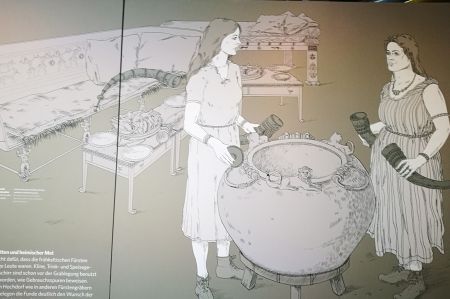Singidunum - main castle of the Celtic group Skordiscian
- Written by Portal Editor
The area at the mouth of the river Sava into the Danube, now place of the Serbian capital Belgrade, has been continuously inhabited since the middle of the Palaeolithic period.
Traces of the Neolithic Vinča culture, from between the 6th and 3rd millennium BC, in the area of the middle Danube, still appear in the name of a Belgrade suburb today. According to the archaeologist Constantin Josef Jireček, a Celtic settlement, initiated by the Skordiscian folks, was replaced by a Roman fortification later on:
"They founded their main castle, Singidunum, whose fortification might just have consisted of a cyclopian wall. After the subjugation of Moesia, the suburbs of the Skordiscians became one of the most important castrums of the Romans. At the place of the primitive Celtic castle, a regular Roman castrum rose, but the old name retained, which continued until VII century as the last trace of the Celtic element, which had already been lost."
In general, the pre-Roman epoch of the later Roman province of Moesia was connected with the founding of the pre-Roman Singidunum with the Skordiscian folks, a Thracian-Celtic tribe. The great migration of the Celtic tribes to the Danube, and finally to the region around Ankara, as well as their settlement in the later Roman province of Pannonia at the mouth of the river Sava into the Danube.
The Skordiscian were a Thracian, Illyrian mixed Celtic tribe on the territory of today's states of Serbia and Croatia. They first appear in the ancient literature at Strabo. Archaeologically, Celtic influences in the area exist from about 300 BC.
The Skordiscians fell into Greece in the 3rd century BC and after their defeat at Delphi at 279 BC they turned back to the east of the later Roman metropolis Sirmium, today's Sremska Mitrovica. At Belgrade they made an oppidum, a new settlement. They played an important role in the development of Trans Danubia. Strabo distinguished the neighboring Large Skordiscian and the Small Skordiscian, which are supposed to have mixed with the residential population (Illyrian and Daker), which is confirmed by the archeology too.
The Germanic Cimbri, Teutones and Ambrones, reached the area of the Skordiscian during their migration. As the latter repeatedly invaded Macedonia, they lived in conflict with Rome for a long time. Around the turn of the 2nd century BC to the 1st century BC several Roman governors led campaigns against the Scordisci:
114 BC the Romans are leading an unsuccessful campaign against the Skordiscians, they needed to have subjected themselves to Roman control, which was rewarded with a limited autonomy.
The effect of the Celtic migration had a long-lasting effect on the history of the Balkan peninsula, which was characterized by campaigns to Macedonia and Greece as well as a hike to distant Galatian Asia. In what way they got to the Save however remains unclear. The fact that it was already in the early 3rd century BC is stated by archaeological finds in Gomolava, as well as the discovery of the Neolithic necropolis of Rospi Čuprija in the Karaburma district near Belgrade (a few kilometers east of the Roman Singidunum), as well as in Viminacium. The settlement of the Skordicians at the mouth of the Save and the founding of Singidunum will be extended by the advances around 280 BC.
At first the Skordiscians fought with several tribal groups, one indirectly described by Herodot in the designation of the tribal plain at the mouth of the rivers Angros (Western Morava) and Brongos (Southern Morava) for the Balkan peninsula, as well as other Thracian tribes. The death of the Macedonian king Ptolemy Keraunos in the year 279 BC during the fight against the Skordiscians, opened the road to Greece. After the failure to plunder the Delphi treasures and the suicide of the leader Brennus, a part of the Skordiscians returned from Greece to the Save and settled down permanently.
The appearance of the Celts at the mouth of the Sava had been described by the historian Iustinus after his return from Delphi:
"The Celts, who have led the war against Delphi unhappily, with whom they have rather felt the power of God, have fled after the death of their leader Brennus, and have partly been defeated to Thrace and partly to Asia Minor. From here they came back to their homeland on the same road as the campaign. A group of these settled at the Sava mouth, and began to be called Skordiscian. "- Iustinus: Epitoms XXXII 3, 6-8
However, due to the archaeological finds in Rospi Čupria, the presence of the Celts is already attested before this time at Singidunum. Strabon also reported on the spread of the Skordiscian, which reached to the settlements of the tribal group called Moeser. The archaeological finds in Rospi Čupria are particularly rich in the oldest period, but they are also rich in the 80s of the 1st century BC, the material culture of the Skordiscian was characterized by a strong intermingling with the cultures of the tribal and autarchies. The decline of the Skordicians in Moesia was explained by Appian in the battles with the tribalists and later the Romans. Claudius Ptolemy knew the Skordiscians only from Pannonia, where epigraphic testimony still survived until the 2nd century AD.
Please read as well:
Roman construction - insights into technology
Belgrade - The fortress on the river mouth at Sava-Danube
-
-
-
-
-
-
-
-
-
-
-
-
https://www.alaturka.info/en/history/antiquity/4151-singidunum-main-castle-of-the-celtic-group-of-the-skordiscian/amp#sigProId15ff841fa0
